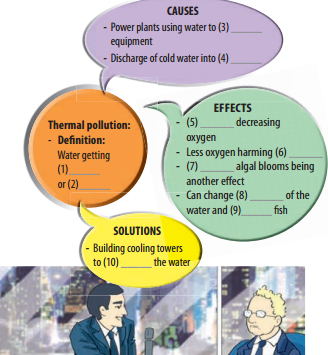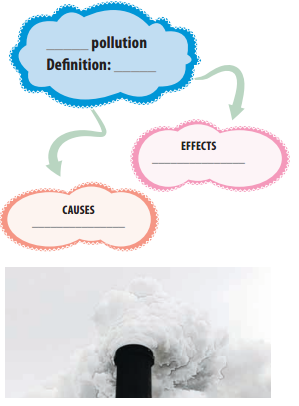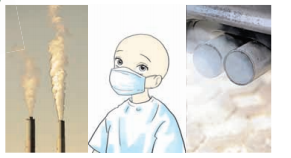Unit 7 : Pollution?
Skills 2
*Objectives:
By the end of the lesson, Ss will be able to:
-Listen to a conversation on TV between a reporter and an environmentalist about thermal pollution.
-Write an article about causes and effects of a type of pollution in their area.
Bài 1. Miêu tả những gì em xem trong hình và nói về mối quan hệ giữa chúng.
Click tại đây để nghe:

The first picture shows an algal bloom in coastal seawater.
Hình ảnh dầu tiên cho thấy sự nở hoa của tảo trong nước biển ven bờ.
The second picture shows the cooling towers from a power station.
Hình ảnh thứ hai cho thấy các tháp làm mát từ một trạm điện.
They are both related to thermal pollution.
Cả hai đều liên quan đến ô nhiễm nhiệt.
Bài 2. Nghe phần bài đàm thoại trên ti vi giữa một phát thành viên và nhà môi trường học về ô nhiễm nhiệt. Hoàn thành bảng biểu. Sử dụng không hơn 3 từ cho mỗi chỗ trống.
Click tại đây để nghe:

(1) hotter
(2) cooler
(3) cool
(4) warm rivers
(5) warm water
(6) fish populations
(7) harmful
(8) colour
(9)poison
(10) cool down
Ô nhiễm nhiệt
Định nghĩa: nước nóng hơn hoặc mát hơn Nguyên nhân:
– Nhà máy nhiệt điện sử dụng nước để làm mát thiết bị.
– Thải nước nóng vào những dòng sông.
Hậu quả:
– Nước nóng hơn làm giảm lượng ôxi.
– ít ôxi làm hại đàn cá.
– Sự phát triển của những tảo gây hại cũng là hậu quả khác.
– Có thể thay đổi màu sắc của nước và gây ngộ độc cá.
Giải pháp:
– Xây dựng những tháp làm mát để làm nguội nước.
Audio script:
Reporter: Does thermal pollution mean that bodies of water get hotter, Mr Nam?
Mr Nam: Not always. Sometimes the water becomes colder, and that’s also thermal pollution means a change in the water temperature.
Reporter: That’s interesting! What causes
Mr Nam: Power station are one factor. They use water in the nearby lakes or rivers to cool their equipment, which heats up the water. Then they dump the hot water back into its source.
Reporter: Are there any other causes?
Mr Nam: Yes. Thermal pollution may also happen due to the discharge of cold water from reservoirs into warm rivers.
Reporter: Thermal pollution can have dramatic effects. Right?
Mr Nam: Certainly. Most aquatic creatures need a certain temperature to survive. Warmer water has less oxygen in it, and this can harm fish populations. Besides, warmer water can cause harmful algalblooms. This can change the colour of the water like in the first picture and, more seriously, the algea poisons the fish.
Reporter: What can we do, Mr Nam?
Mr Nam: In many places, they build cooling towers like in the second picture to cool down the water from power stations.
Reporter: Anything else we can do?…
Bài 3. Làm theo cặp. Thảo luận những nguyên nhân và hậu quả của một trong những loại ô nhiễm trong khu vực em. Ghi chú vào biểu đồ.

Air pollution Ô nhiễm không khí
Definition: Air pollution occurs when the air contains gases, dust, fumes or odour in harmful amounts
Định nghĩa: Ô nhiễm không khí xảy ra khi không khí chứa khí độc, bụi, khói hoặc mùi hôi với số lượng nguy hiểm.
Cause: industrial watse, exhaust from car and plane…
Nguyên nhân: chất thải công nghiệp, khí thải từ xe hơi và máy bay… Effect: causing diseases, death to humans, damage to other living organisms such as animals and food crops, or the natural or built environment.
Hậu quả: gây ra những căn bệnh, cái chết cho con người, gây hại đến quần thể sống như động vật và vụ mùa thực phẩm, hoặc môi trường thiên nhiên hoặc kiến trúc môi trường.
Bài 4. Tưởng tượng rằng em đang viết một bài báo cho một tờ báo địa phương về một loại ô nhiễm trong khu vực em. Một trong các bạn viết về nguyên nhân và những người khác viết về hậu quả, sau đó thảo luận.

Soil pollution happens when human activities destroy the earth’s surface.
Ô nhiễm đất xảy ra khi những hoạt động của con người phá hủy bề mặt trái đất.
Cause: pesticides, herbicides, chemical industrial watse, deforestation… Nguyên nhân: thuốc trừ sâu, thuốc diệt cỏ, chất thải công nghiệp hóa chất, nạn phá rừng…
Effect: soil pollution, the upper layer of soil is damaged, effect on wild-life… Tác động: ô nhiễm đất, lớp đất mặt bị hư, tác động lên động vật hoang dã…
Bài 5. Đọc bài của mỗi người và đặt chúng cùng nhau để làm bài hoàn chỉnh.




Comments mới nhất